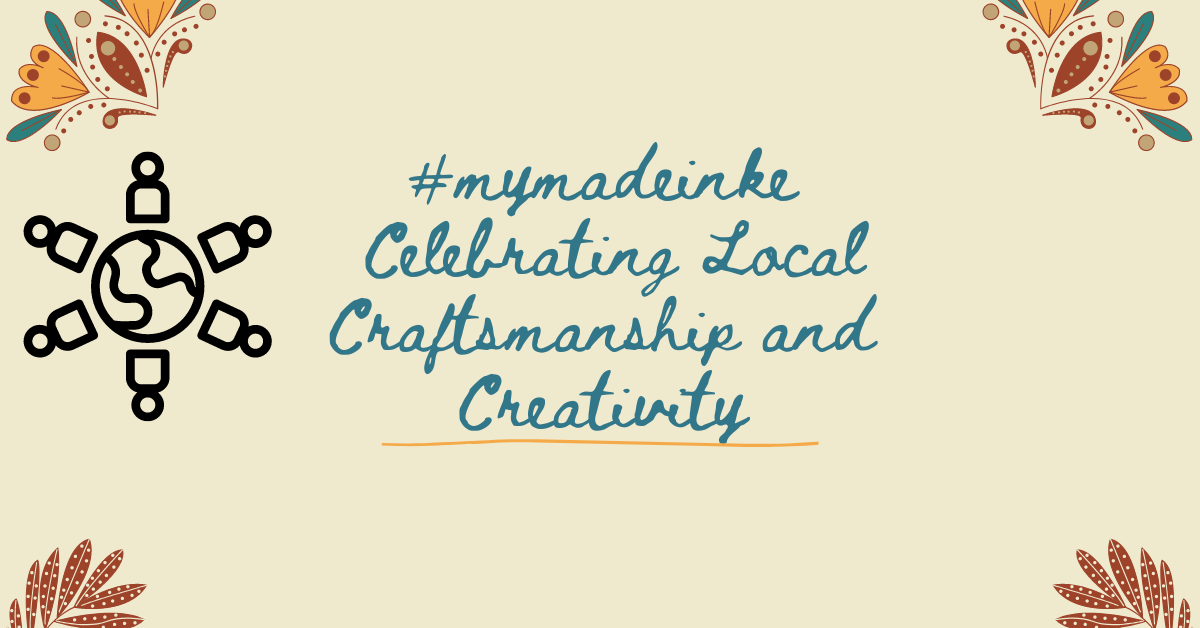Culture
#MyMadeInKe: Celebrating Local Craftsmanship and Creativity

In the era of globalization and mass production, the #MyMadeInKe movement stands as a beacon of pride, creativity, and community spirit. This vibrant hashtag has evolved into much more than a social media trend; it represents a cultural shift towards valuing handmade, artisanal products and supporting local businesses. In this in-depth exploration, we will delve into the origins, significance, and impact of #MyMadeInKe, examining how it has become a symbol of innovation, authenticity, and economic empowerment.
Origins and Evolution of #MyMadeInKe
The genesis of #MyMadeInKe can be traced back to a collective desire among local artisans, creators, and entrepreneurs in Kenya to showcase their talents and products on a global platform. The hashtag emerged as a grassroots movement, initially focused on highlighting the craftsmanship and cultural richness of Kenyan-made products. As artisans began sharing their creations online using the hashtag, it quickly gained traction and drew attention to the diversity and quality of locally produced goods.
One of the key drivers behind #MyMadeInKe was the need to counterbalance the dominance of mass-produced, generic products flooding the market. Local businesses often struggled to compete with larger corporations that had extensive marketing budgets and global reach. The hashtag provided a cost-effective and accessible way for artisans to showcase their unique offerings and connect directly with consumers who appreciated the value of handmade items.
As #MyMadeInKe gained momentum, its reach extended beyond Kenya’s borders. Artisans from other African countries and beyond embraced the hashtag, recognizing its power to promote locally made goods and celebrate cultural heritage. This expansion transformed #MyMadeInKe into a global movement, transcending geographical boundaries and fostering cross-cultural exchanges.
The Significance of #MyMadeInKe
At its core, #MyMadeInKe symbolizes a shift in consumer preferences towards authenticity, sustainability, and ethical consumption. Modern consumers are increasingly conscious of the environmental and social impact of their purchasing decisions. By choosing products tagged with #MyMadeInKe, they signal their support for local economies, artisanal craftsmanship, and sustainable practices.
Moreover, #MyMadeInKe is a testament to the power of social media in democratizing access to markets and amplifying marginalized voices. Artisans who were once overlooked or marginalized in traditional retail channels now have a platform to showcase their talents and build a global customer base. This democratization of commerce empowers artisans to retain control over their creative process, pricing, and distribution channels.
The movement also fosters a sense of community among artisans, entrepreneurs, and consumers. Through the shared experience of appreciating and creating handmade goods, individuals form connections and collaborations that enrich the creative landscape. Events such as artisan markets, workshops, and online forums further strengthen this sense of community and encourage knowledge sharing and skill development.
Economic Impact and Empowerment
The economic impact of #MyMadeInKe cannot be overstated. By promoting local businesses and encouraging consumer support, the movement contributes to job creation, income generation, and overall economic development. Small and medium-sized enterprises (SMEs) play a crucial role in driving economic growth and reducing poverty, particularly in developing countries.
#MyMadeInKe provides a platform for these enterprises to thrive and compete in the global marketplace. It enables them to tell their stories, connect with customers directly, and differentiate their products based on quality, craftsmanship, and authenticity. This, in turn, leads to increased sales, brand recognition, and opportunities for expansion.
Furthermore, #MyMadeInKe aligns with the principles of sustainable development by promoting local sourcing, reducing carbon footprints, and preserving cultural heritage. Many artisans incorporate eco-friendly practices into their production processes, such as using recycled materials, minimizing waste, and supporting fair trade practices. This commitment to sustainability resonates with environmentally conscious consumers and adds another layer of value to #MyMadeInKe products.
Innovation and Excellence
Far from being static, #MyMadeInKe fuels a culture of innovation and excellence among artisans and entrepreneurs. The movement encourages experimentation with new materials, techniques, and designs, leading to the creation of innovative products that blend tradition with modernity. Artisans are not bound by mass production constraints or market trends; they have the freedom to explore their creativity and push boundaries.
The competitive environment fostered by #MyMadeInKe drives continuous improvement and quality assurance. Artisans strive to deliver products that exceed customer expectations in terms of craftsmanship, durability, and aesthetic appeal. This commitment to excellence elevates the overall perception of locally made goods and positions them as desirable alternatives to mass-produced counterparts.
Challenges and Opportunities
Despite its many benefits, #MyMadeInKe faces challenges that warrant attention and collaboration. One such challenge is access to markets and distribution channels. While social media platforms provide a starting point for showcasing products, artisans often struggle to reach broader audiences and secure consistent sales. Collaborations with retailers, e-commerce platforms, and export agencies can help bridge this gap and facilitate market access.
Another challenge is ensuring fair compensation and working conditions for artisans. The pricing of handmade goods must reflect the time, skill, and effort invested by artisans, while also remaining competitive in the market. Transparent pricing practices, ethical sourcing, and partnerships with organizations that promote fair trade can address these challenges and enhance the credibility of #MyMadeInKe products.
On the flip side, #MyMadeInKe presents numerous opportunities for growth and collaboration. Partnerships with designers, influencers, and cultural institutions can elevate the visibility and desirability of locally made goods. Educational initiatives focused on traditional crafts and artisanal skills can nurture the next generation of talent and preserve cultural heritage.
The Future of #MyMadeInKe
Looking ahead, the future of #MyMadeInKe is promising yet dynamic. The movement will continue to evolve in response to changing consumer preferences, technological advancements, and global trends. Digital platforms and e-commerce innovations will play a crucial role in expanding market reach and streamlining sales processes for artisans.
Collaborations between governments, private sector stakeholders, and civil society organizations can further support the growth of #MyMadeInKe. Investment in infrastructure, skills development, and market access initiatives can create an enabling environment for artisans to thrive and contribute to inclusive economic growth.
Moreover, #MyMadeInKe has the potential to inspire similar movements in other regions and sectors. The principles of celebrating local craftsmanship, fostering innovation, and supporting sustainable practices are universal and can be applied across diverse industries.
Conclusion
In conclusion, #MyMadeInKe represents a powerful convergence of creativity, community, and commerce. It celebrates the ingenuity of artisans, promotes economic empowerment, and enriches cultural exchange. As consumers increasingly prioritize authenticity and sustainability, the #MyMadeInKe movement serves as a model for responsible consumption and inclusive economic development. By continuing to champion local talent and creativity, we can build a more resilient, equitable, and vibrant global economy.
Culture
Örviri: Exploring the Mystical Heritage

Örviri, a term steeped in cultural heritage and mystique, encapsulates the essence of indigenous beliefs and traditions. This article delves into the historical significance, cultural impact, modern adaptations, and conservation challenges surrounding Örviri.
Historical Background
Örviri traces its roots back centuries, intertwining with ancient ceremonies and spiritual practices. The rituals associated with Örviri were often centered around celestial events and natural phenomena, showcasing a deep connection with the cosmos and the earth.
Cultural Significance
Indigenous Beliefs
Within indigenous communities, Örvir;i holds a sacred place, symbolizing harmony with nature and ancestral wisdom. The rituals and ceremonies associated with Örviri are believed to invoke blessings, protection, and spiritual enlightenment.
Festivals and Rituals
Across generations, Örviri festivals have been celebrated with fervor and reverence. These gatherings not only honor tradition but also serve as a time for communal bonding, storytelling, and passing down cultural legacies.
Örviri in Modern Context
Contemporary Art
In recent years, Örvir;i has inspired contemporary artists, leading to a revival of traditional motifs and practices in various art forms. This cultural resurgence has sparked interest globally, bridging ancient wisdom with modern interpretations.
Tourism Impact
The allure of Örviri has also made it a focal point for cultural tourism. Travelers seeking authentic experiences are drawn to regions where Örvir’i traditions are preserved, contributing to local economies while fostering cross-cultural exchanges.
Conservation Efforts
Environmental Concerns
As urbanization encroaches upon natural landscapes, preserving Örviri’s sacred sites and ecological balance has become paramount. Conservationists and indigenous communities are working together to safeguard these heritage sites for future generations.
Community Initiatives
Through community-led initiatives, efforts are underway to promote sustainable practices and raise awareness about Örviri’s cultural significance. These initiatives empower local communities to be stewards of their heritage while fostering pride and resilience.
Örviri’s Influence on Local Economy
The cultural heritage associated with Örvir;i has also become a driver for economic development. Artisanal crafts, cultural performances, and eco-tourism ventures centered around Örviri have created livelihood opportunities and diversified local economies.
Challenges and Threats
Urbanization
Rapid urban development poses a threat to Örviri’s traditional landscapes and practices. Balancing modernization with heritage preservation is a delicate task requiring collaboration between policymakers, communities, and conservationists.
Also Read: Jablw.rv: Revolutionizing Digital Spaces
Globalization
Global influences and commercialization can dilute the authenticity of Örviri’s traditions. Striking a balance between cultural exchange and safeguarding intangible heritage is essential to ensure Örviri’s legacy endures authentically.
Future Prospects
Despite challenges, the future of Örviri remains hopeful. Through sustainable practices, cultural education, and innovative partnerships, Örviri can continue to thrive as a beacon of cultural resilience and environmental stewardship.
Conclusion
Örviri’s journey from ancient rituals to modern interpretations reflects the resilience and adaptability of indigenous cultures. By valuing and protecting Örviri’s heritage, we not only preserve a rich cultural tapestry but also embrace diversity and sustainability.
FAQs
What does Örviri signify?
Örviri symbolizes the interconnectedness of indigenous beliefs with nature and ancestral wisdom.
How has Örviri influenced contemporary art?
Örviri has inspired artists to revive traditional motifs and practices in various art forms, blending ancient wisdom with modern interpretations.
What are the major challenges facing Örviri’s conservation?
Urbanization, globalization, and environmental degradation pose significant challenges to preserving Örviri’s heritage and landscapes.
How does Örviri contribute to the local economy?
Örviri’s cultural heritage drives economic development through artisanal crafts, cultural tourism, and eco-friendly initiatives, creating livelihood opportunities.
What can individuals do to support Örviri’s preservation?
Individuals can support Örviri’s preservation by engaging in sustainable tourism, advocating for cultural conservation policies, and supporting local initiatives.
Culture
Rebeldemente: Embracing Individuality with Courage

In a world that often emphasizes conformity and uniformity, the concept of “rebeldemente” stands out as a powerful testament to individuality and courage. Originating from Spanish, “rebeldemente” encapsulates a rebellious spirit that defies norms and embraces authenticity. This article explores the depth and significance of being “rebeldement;e” in various aspects of life, from culture and art to personal growth and mindset.
What does “rebeldement;e” mean?
The term “rebeldemente” translates to “rebelliously” in English, but its essence goes beyond mere defiance. It embodies a fearless attitude towards expressing oneself authentically, regardless of societal expectations or norms. Being “rebeldement;e” involves embracing one’s uniqueness and daring to stand out in a world that often encourages conformity.
Origin and evolution of “rebeldemente”
The roots of “rebeldement;e” can be traced back to the human desire for freedom and self-expression. Throughout history, individuals and movements have emerged, embodying the spirit of “rebeldement;e” in various forms, from artistic revolutions to social activism. Over time, the concept has evolved to encompass a wide range of attitudes and behaviors that challenge the status quo.
Cultural impact of “rebeldemente”
In culture, “rebeldemente” serves as a catalyst for innovation and creativity. It inspires artists, musicians, writers, and creators of all kinds to push boundaries and explore new territories. From rebellious art movements to groundbreaking music genres, the influence of “rebeldemen;te” can be seen across different cultural landscapes.
How “rebeldemente” influences society
The impact of being “rebeldement;e” extends beyond individual expression; it can spark social change and redefine norms. By questioning existing structures and advocating for authenticity, “rebelde-mente” encourages society to embrace diversity and celebrate individuality.
Expressing “rebeldemente” through art and music
Art and music have always been powerful mediums for expressing “rebeldemente.” Whether through provocative paintings, revolutionary songs, or avant-garde performances, artists use their platforms to challenge conventions and inspire others to embrace their unique perspectives.
“Rebeldemente” in fashion and lifestyle
Fashion and lifestyle choices often reflect one’s “rebeldement;e” spirit. From unconventional clothing styles to alternative lifestyles, individuals who embody “rebeldement;e” are unafraid to defy fashion norms and express themselves authentically.
Psychological aspects of being “rebeldement;e”
Psychologically, being “rebeldement;e” can contribute to a strong sense of self-esteem and identity. By embracing one’s true self and standing up for what they believe in, individuals cultivate resilience and confidence in navigating life’s challenges.
Read More: Eugenio Pallisco Michigan: Exploring the Legacy of a Visionary Leader
Embracing individuality through “rebeldement;e”
At its core, “rebeldement;e” is about celebrating individuality and encouraging others to do the same. It’s a reminder that conformity should never stifle personal growth or authenticity.
The role of “rebeldemente” in personal growth
For many, embracing a “rebeldemen;te” mindset is a journey of self-discovery and empowerment. It involves breaking free from limiting beliefs and societal pressures to live life on one’s own terms.
Challenges and misconceptions associated with “rebeldemente”
However, being “rebeldemente” isn’t without its challenges. Misconceptions and stereotypes can sometimes overshadow the positive aspects of embracing individuality. Overcoming these hurdles requires resilience and a strong sense of self-awareness.
Nurturing a positive “rebeldemente” mindset
To nurture a positive “rebeldement;e” mindset, it’s essential to cultivate self-acceptance and authenticity. Surrounding oneself with supportive communities and role models can also provide encouragement and inspiration along the journey.
Inspiring quotes about “rebeldement;e”
- “Be unapologetically yourself; that’s the essence of being ‘rebeldemente.'” – Unknown
- “Embrace your quirks and differences; they make you beautifully ‘rebeldemente.'” – Anonymous
- “Don’t be afraid to rock the boat; sometimes, the best views come from riding the waves.” – Author Unknown
Conclusion
In conclusion, “rebeldemente” is not just a word; it’s a mindset—a way of life that celebrates individuality, authenticity, and courage. By embracing the “rebeldement;e” spirit, individuals can unlock their true potential and inspire positive change in themselves and the world around them.
Culture
Chainiste Craft: An Artistic Journey through Time

Chainiste craft, a traditional art form cherished for its intricate designs and meticulous craftsmanship, has a rich history that intertwines with cultural heritage and artistic expression. From ancient origins to modern interpretations, this article delves into the captivating world of Chainiste Craft, exploring its techniques, significance, and enduring allure.
Introduction to Chainiste Craft
Chainiste Craft, also known as chainmaille or chainmail, is the art of creating intricate patterns using interlocking metal rings. This ancient technique dates back to as early as the 4th century BCE and has evolved significantly over time, transcending its utilitarian origins to become a symbol of craftsmanship and creativity.
History and Origins of Chainiste Craft
The origins of Chainiste Craft can be traced back to civilizations such as the Celts, who used chainmail for protective armor during battles. Over the centuries, this craft spread across continents, with each culture adding its unique flair and techniques to the art form.
The Art of Chainiste Craftsmanship
· Materials Used
Chainiste Craft utilizes various metals, including stainless steel, copper, aluminum, and precious metals like gold and silver. Each metal lends distinct properties to the final piece, from durability to aesthetic appeal.
· Techniques Involved
Craftspeople employ intricate weaving and linking techniques to create mesmerizing patterns, from classic weaves like Byzantine and European 4-in-1 to more complex designs such as Dragonscale and Helm Chain.
Popular Chainiste Craft Products
Chainist;e Craft finds expression in a myriad of products, including:
- Jewelry: Chainiste Craft jewelry, ranging from delicate earrings to bold statement necklaces, showcases the artistry and versatility of this craft.
- Home Decor: Decorative chainmaille items like curtains, lampshades, and wall hangings add a touch of elegance and uniqueness to living spaces.
- Fashion Accessories: Belts, handbags, and even footwear adorned with chainmaille accents elevate fashion with a blend of tradition and modernity.
Significance and Cultural Impact of Chainiste Craft
Beyond its aesthetic appeal, Chainiste Craft holds cultural significance, often symbolizing strength, unity, and craftsmanship excellence. In folklore and mythology, chainmaille is associated with protection and resilience, adding layers of meaning to its timeless allure.
Also Read: Blunturi: A Deep Dive into Culture, Crafting, and Community
Modern Trends in Chainiste Craft
In today’s era, Chainiste Craft has witnessed a resurgence, fueled by:
- Sustainability Practices: Embracing eco-friendly materials and ethical production methods.
- Innovative Designs: Pushing boundaries with contemporary designs and incorporating non-traditional elements.
The Future of Chainiste Craft
As artisans and enthusiasts continue to innovate and collaborate, the future of Chainist;e Craft shines bright, bridging tradition with modernity and captivating a new generation of admirers.
Conclusion
In conclusion, Chainiste Craft stands as a testament to human creativity, craftsmanship, and cultural heritage. Its timeless beauty and enduring appeal make it a cherished art form that continues to captivate and inspire.
FAQs (Frequently Asked Questions)
What is the difference between chainmail and chainmaille?
Chainmail refers to armor made of interlinked metal rings, historically used for protection in battles. Chainmaille, on the other hand, refers to the art form of creating decorative patterns using similar interlocking rings.
Can chainmaille jewelry be worn daily?
Yes, chainmaille jewelry crafted from durable materials like stainless steel or titanium can be worn daily with proper care and maintenance.
Is chainmaille difficult to learn?
While mastering intricate weaves may require practice, basic chainmaille patterns can be learned with patience and dedication, making it accessible to beginners.
Are there modern applications of chainmaille beyond fashion and decor?
Yes, chainmaille’s durability and flexibility have found applications in industries like aerospace and technology, showcasing its versatility beyond traditional uses.
How can one support artisans practicing chainiste craft?
Supporting local artisans, purchasing handmade chainmaille products, and spreading awareness about the craft’s cultural significance are meaningful ways to support the chainis;te craft community.
-

 Health3 months ago
Health3 months agoUnveiling Blisterata: Exploring the Controversy, Ingredients, Effects, and Comparisons in the Supplement World
-

 Technology4 months ago
Technology4 months agoReplay Music 11.0.0.0 Crack Registration Code Full Download 2023
-

 Entertainment3 months ago
Entertainment3 months agoDepths of “Serial Killer Isekai ni Oritatsu” Chapter 7: A Journey into Darkness and Revelation
-

 Technology4 months ago
Technology4 months agoWondershare Filmora 10.7.0.10 Crack + Registration Code Download 2021
-

 Technology4 months ago
Technology4 months agoWindows 7 Home Premium Crack Product Key Full Download 2023
-

 Technology4 months ago
Technology4 months agoTag&Rename 3.9.15 Crack + Registration Key Full Version Download 2021
-

 Food & Drink3 months ago
Food & Drink3 months agoThe Versatile Çeciir: A Nutritious Addition to Your Diet
-

 Business4 months ago
Business4 months agoJablw.rv: Revolutionizing Digital Spaces
